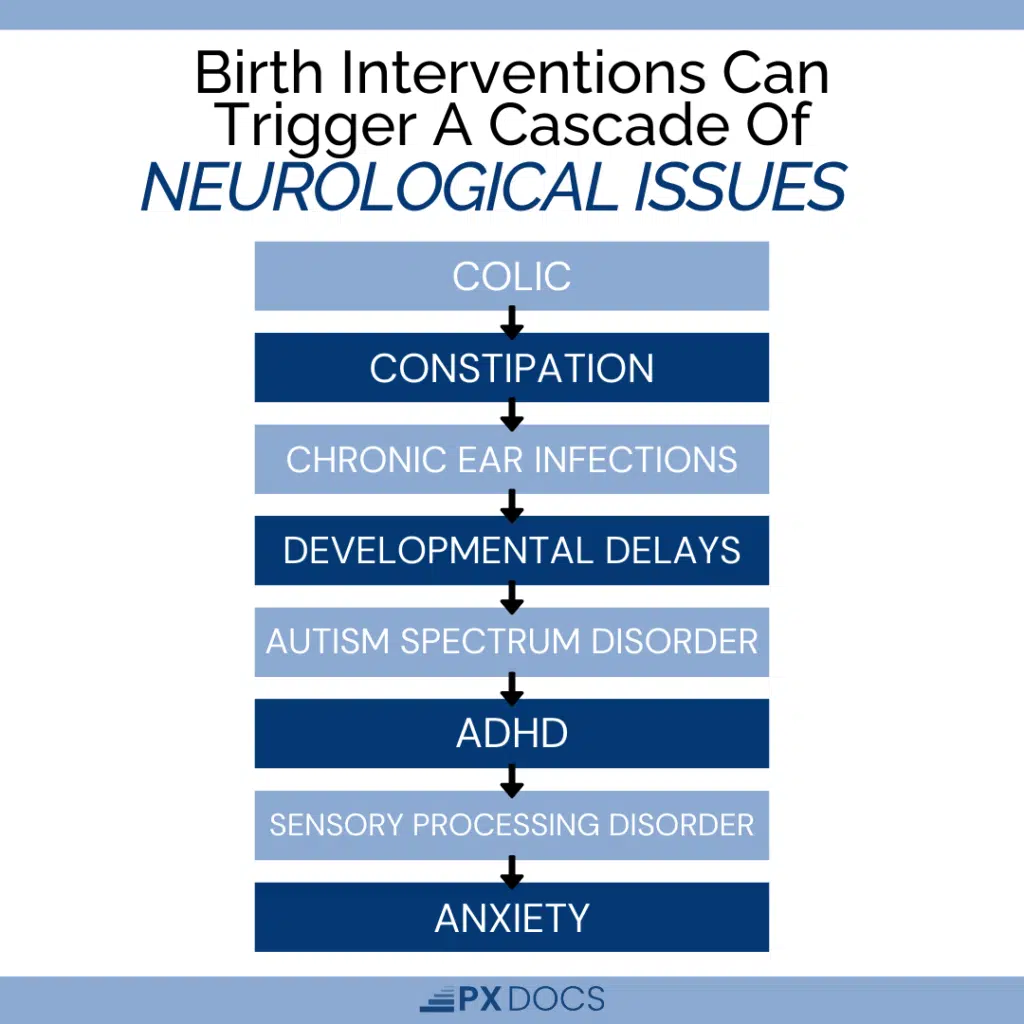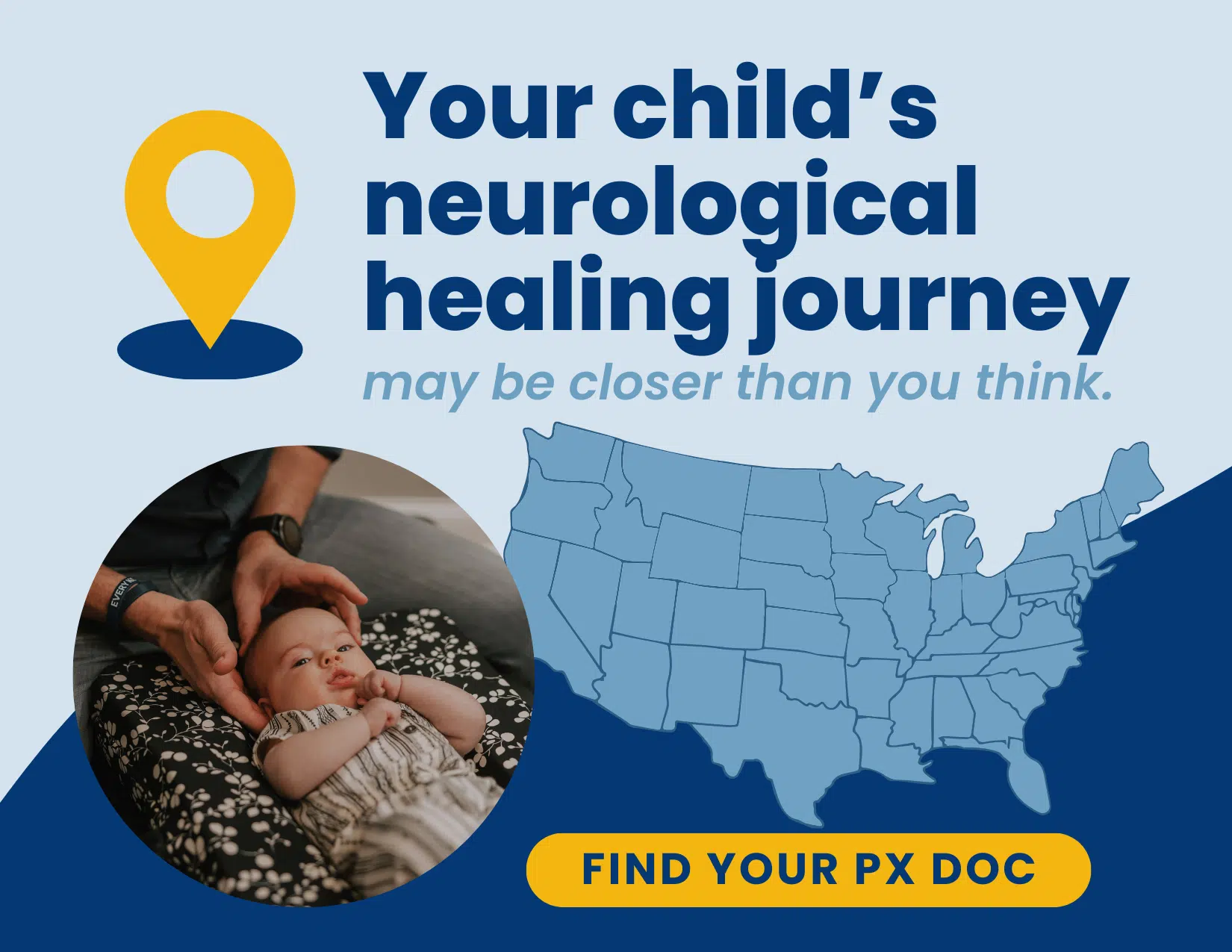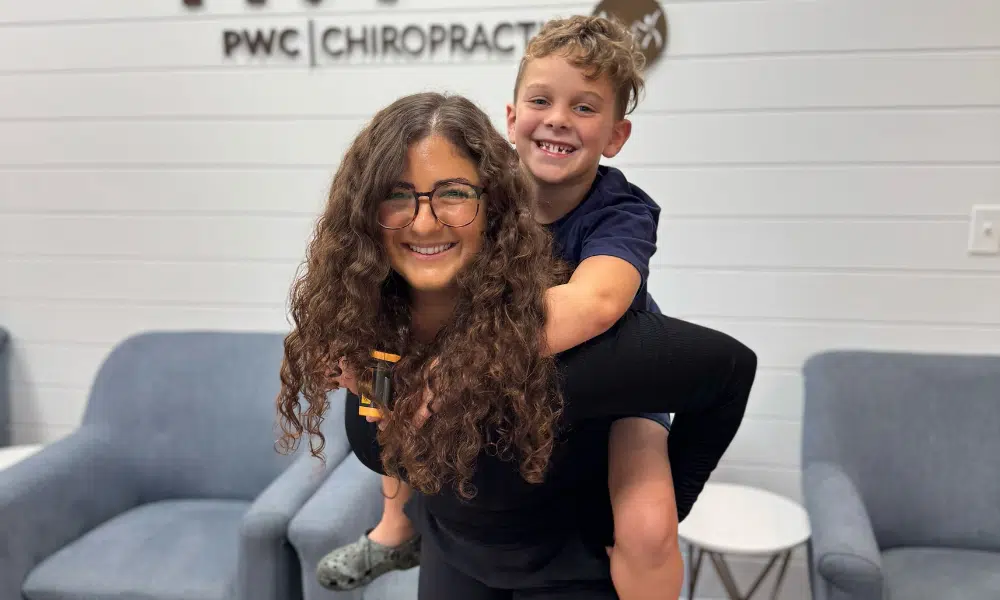As a parent, there’s nothing more heartbreaking than watching your child struggle with chronic health issues like digestive problems, sleep disturbances, or developmental delays. According to the CDC, 40% of kids have some chronic health condition.
When a child struggles with chronic illness and multiple conditions, parents are almost immediately sent into what we call the “specialist merry go round” where all of a sudden they’ve got appointments and testing in motion all at once with a neurologist, immunologist, ENT, GI specialist, PT, OT, Speech Therapist, and so forth. Once this conventional, siloed medical system gets rolling the appointments, testing, and medications start to stack up and get piled on fast.
But instead of getting the answers, explanations, and root cause solutions they seek – parents today often end up more frustrated, confused, exhausted, and disappointed with their medical care than ever.
This then leads them to the natural or holistic side of healthcare searching for the answer to one single question – why is their child so sick?
While conventional medicine blames genetics and natural health experts blame chemicals and toxins, when we dig deep into the case histories of children struggling with chronic health challenges we frequently find something that might surprise you – birth trauma.
While we tend to think of birth trauma only in the cases of severe injuries and situations, the truth is birth trauma can have a varied presentation based upon the type of injury sustained.
In this article, we’ll take a deep dive into the science of birth trauma and its lasting impact on a child’s developing nervous system and overall health. We’ll explore how common birth interventions can trigger a cascade of neurological issues, setting the stage for a wide range of chronic health challenges. Most importantly, we’ll introduce you to a revolutionary approach to addressing birth trauma through Neurologically-Focused Chiropractic Care—a potential game-changer for your child’s health and well-being.
Get ready to discover the hidden connection between birth trauma and your child’s struggles, and find hope in a solution that goes beyond symptom management to address the root cause of their challenges.
What is Birth Trauma?
From a Neurologically-Focused Chiropractic Care perspective, birth trauma refers to the physical and neurological stress placed on an infant’s spine and nervous system during the birthing process, particularly when interventions such as forceps, vacuum extraction, induction, epidurals, or cesarean sections are used. These interventions, while often medically necessary, can place excessive pressure on the delicate nerves and tissues of the baby’s upper neck and brainstem area, especially the vagus nerve, which is critical in regulating essential functions such as breathing, digestion, sleep, immune response, and the modulation of inflammation.
This trauma can result in subluxation, or misalignment of the spine, leading to neurological interference that disrupts the infant’s ability to adapt, thrive, and develop optimally. Many common pediatric issues, such as colic, reflux, sleep disturbances, immune challenges, and developmental delays, can be linked to the hidden effects of birth trauma on the nervous system.
Some of the most common causes of birth trauma include:
- Forceps delivery: Metal instruments are used to grasp the baby’s head and guide them out of the birth canal, potentially causing strain on the neck and skull.
- Vacuum extraction: A suction cup is applied to the baby’s head to assist with delivery, which can lead to severe amounts of pulling, twisting, distortion, and injury to not just the cranium but also the upper cervical spine, spinal cord, and dural meningeal system
- Cesarean section (C-section): While often used in emergencies, C-sections now account for about a third of all deliveries in the U.S. and bypass the natural compression of the birth canal, which can result in retained fluid and tension in the baby’s body, along with all sorts of other complications and chronic health implications
- Prolonged labor: Extended periods of pressure on the baby’s head and neck can cause structural shifts and neurological stress.
- Breech position: When a baby is born feet or bottom first, there is an increased risk of injury to the head, neck, and neurospinal system not just during delivery, but throughout in-utero fetal development. Breech position also greatly increases the chances of the above interventions being used as well, along with their related complications.
It’s important to note that while these interventions can be life-saving in certain circumstances, they are often overused in modern medical practice. The World Health Organization has stated that C-sections are generally overused and not medically necessary in many cases.
From Dr. Ian Askew, Director of WHO’s Department of Sexual and Reproductive Health, “But not all the cesarean sections carried out at the moment are needed for medical reasons. Unnecessary surgical procedures can be harmful, both for a woman and her baby.”
Recent studies have also shown that assisted deliveries, particularly those involving forceps and vacuum extraction, are more common than previously thought.
The Neurological Impact of Birth Trauma
To understand how birth trauma can lead to a wide range of chronic health issues in children, it’s essential to explore its impact on the developing nervous system. At the core of this connection lies subluxation, which sets the stage for a cascade of neurological dysfunction we refer to as “The Perfect Storm.”
Subluxation: The Root of Neurological Dysfunction
Subluxation, from a Neurologically-Focused Chiropractic Care perspective, refers to a neurological dysfunction caused by misalignments, tension, and restricted mobility within the neurospinal system. This dysfunction interferes with communication between the brain and body via the nervous system, disrupting the body’s ability to regulate and adapt to its environment. As a result, an imbalance in the autonomic nervous system occurs, leading to a range of physical, mental, and emotional health challenges.
The main components of subluxation include misalignment and limited motion, neurological interference, autonomic imbalance (dysautonomia), and multi-system dysfunction.
Subluxation is not just seen as a structural issue in the spine but as a more profound disruption in the body’s natural ability to communicate, adapt, and heal.
The Vagus Nerve: The Key to Rest and Digest
One of the most critical components of the autonomic nervous system is the vagus nerve, a long, wandering nerve that extends from the brainstem to the abdomen. The vagus nerve plays a vital role in regulating the parasympathetic “rest and digest” response, which counterbalances the sympathetic “fight or flight” response.
When the vagus nerve is functioning optimally, it helps to:
- Slow down the heart rate and promote relaxation
- Stimulate digestion and nutrient absorption
- Regulate inflammation and support immune function
- Modulate mood and emotional well-being
However, when birth trauma occurs, it can damage or compress the vagus nerve, disrupting its ability to effectively regulate these crucial functions. This nervous system dysregulation can manifest as a wide range of symptoms, such as:
- Colic and digestive issues
- Sleep disturbances and irritability
- Frequent ear infections and respiratory problems
- Developmental delays and sensory processing challenges
- Emotional and behavioral difficulties

“The Perfect Storm”
Birth trauma rarely occurs in isolation. Instead, it often forms part of a “Perfect Storm” of stressors and toxins that can further compromise a child’s neurological development. This framework suggests that the cumulative impact of these factors, beginning from conception and continuing through pregnancy, birth, and early life, can overwhelm the developing nervous system and set the stage for chronic health challenges.
Some of the key components of the “Perfect Storm” include:
- Fertility challenges
- Maternal stress and anxiety during pregnancy
- Exposure to environmental toxins and pollutants
- Poor nutrition and gut health
- Overuse of antibiotics and other medications
- Childhood stress and emotional trauma
When these factors combine with the neurological impact of birth trauma, they can create a vicious cycle of dysfunction that affects multiple systems in the body, leading to the development of conditions such as Autism, ADHD, anxiety, and Sensory Processing Disorder.
By understanding the complex interplay between birth trauma, subluxation, and the “Perfect Storm” of stressors, we can begin to address the roots cause behind the rising rates of chronic health issues in children and explore targeted solutions that address the root cause of these challenges.
Conventional Medical Approaches and Their Limitations
When a child struggles with chronic health issues or developmental delays, parents often turn to their trusted pediatrician or medical professional for guidance and support.
However, the conventional medical approach to these challenges often falls short, failing to acknowledge the role of birth trauma in neurological dysfunction and focusing instead on symptom management.
One of the most significant limitations of the prevailing medical model is its tendency to dismiss or overlook early signs of neurological stress in infants and young children. For example, when a baby experiences colic, reflux, or difficulty latching, these symptoms are often attributed to “normal” developmental challenges that will resolve on their own. In reality, these early indicators may point to an underlying neurological imbalance caused by birth trauma, which, if left unaddressed, can lead to more significant health problems down the road.
Similarly, when a child demonstrates delayed milestones, sensory processing difficulties, or behavioral challenges, conventional medical professionals may be quick to label these symptoms as autism, ADHD, or a learning disability without exploring the potential role of birth trauma and neurological dysfunction in their development. This narrow focus on diagnosis and labeling can lead to a fragmented approach to care, where each symptom is treated in isolation rather than as part of a larger, interconnected system.
Another significant drawback of the conventional approach is its heavy reliance on medication to manage symptoms. While pharmaceuticals can provide temporary relief for some children, they often come with a host of side effects and do little to address the root cause of the child’s challenges. For example, stimulant medications commonly prescribed for ADHD may help to improve focus and reduce hyperactivity in the short term, but they can also lead to sleep disturbances, appetite suppression, and increased anxiety over time.
Moreover, the long-term use of medication to manage neurological symptoms can have unintended consequences for a child’s developing brain and body.
Studies have shown that some antidepressants, particularly selective serotonin reuptake inhibitors (SSRIs), may be associated with cognitive side effects in some patients. A 2016 study found that patients taking SSRIs experienced a statistically significant decline in cognitive function, as measured by the Mini-Mental State Examination (MMSE), over eight weeks of treatment.
Perhaps most concerning is the fact that the conventional medical model often leaves parents feeling dismissed, unsupported, and without a clear path forward for their child’s care. When doctors advise parents to “wait and see” or suggest that their child will simply “outgrow” their challenges, it can be incredibly frustrating and disheartening for families who know intuitively that something isn’t right.
In light of these limitations, it’s clear that a new approach is needed—one that recognizes the complex interplay between birth trauma, neurological dysfunction, and chronic health issues in children. By shifting our focus from symptom management to addressing the root cause of these challenges, we can begin to unlock the potential for true healing and transformation in the lives of affected children and their families.
The PX Docs Approach to Addressing Birth Trauma
At PX Docs, we understand the frustration and heartbreak that comes with watching your child struggle with chronic health issues and developmental challenges. That’s why we’ve developed a unique, neurologically-focused approach to pediatric chiropractic care that aims to address the root cause of these difficulties: birth trauma and its impact on the nervous system.
Our approach is built on the understanding that the nervous system is the master controller of all bodily functions, and that any interference or dysfunction in this delicate system can have far-reaching consequences for a child’s health and well-being.
One of the key tools we use in our practice is the INSiGHT scanning technology, which allows us to objectively assess the function of a child’s nervous system and pinpoint areas of neurological stress and dysfunction. This entire scanning procedure is non-invasive and takes just 15-30 minutes, and then provides us with a detailed map of the child’s neurological dysfunction patterns, enabling us to develop a highly personalized care plan that targets their specific needs and challenges.
Overcoming the Effects of Birth Trauma at the Root
We’ve seen countless children overcome the challenges of birth trauma and go on to thrive in all aspects of their lives. From improved sleep and digestion to enhanced focus and emotional regulation, the benefits of Neurologically-Focused Chiropractic Care are far-reaching and transformative.
Take the story of Liam, a three-year-old boy who struggled with chronic ear infections, digestive issues, and developmental delays since birth. Despite numerous medical interventions and therapies, Liam’s challenges persisted, leaving his parents feeling hopeless and overwhelmed. It wasn’t until they discovered PX Docs and began a course of Neurologically-Focused Chiropractic Care that they finally began to see a change in their son.
After just a few weeks of gentle, consistent adjustments, Liam’s ear infections subsided, his digestion improved, and he began hitting developmental milestones that had once seemed out of reach. His parents watched in awe as their once-struggling child blossomed into a happy, healthy, and confident little boy.
Root Causes, Root Solutions
Stories like Liam’s are not uncommon in our practice. We’ve seen children with autism, ADHD, sensory processing disorder, and a wide range of other neurological challenges experience profound transformations through our care. By addressing the root cause of their difficulties and supporting their nervous system function, we help these children unlock their full potential and thrive in ways they never thought possible.
If you suspect that your child may be struggling with the effects of birth trauma, we encourage you to explore the PX Docs approach to pediatric chiropractic care. Our team of highly trained, compassionate providers is dedicated to helping children overcome the challenges of neurological dysfunction and achieve optimal health and well-being.
Don’t wait another day to give your child the support and care they need to thrive. Visit our directory to learn more about our approach and find a PX Docs provider near you. Together, we can help your child unleash their full potential and experience the vibrant, healthy life they deserve.





